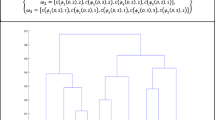Abstract
A probabilistic model of clustering ensemble based on a collection of fuzzy clustering algorithms and a weighted co-association matrix is proposed. An expression for the upper bound of the misclassification probability of an arbitrary pair of objects is obtained depending on the characteristics of the ensemble. This expression is used to determine the optimal weights of the algorithms.
Similar content being viewed by others
References
A. K. Jain, “Data clustering: 50 years beyond kmeans,” Pattern Recogn. Lett. 31 (8), 651–666 (2010).
F. Hoppner, F. Klawonn, R. Kruse, and T. Runkler, Fuzzy Cluster Analysis: Methods for Classification, Data Analysis and Image Recognition (Wiley, 1999).
J. C. Bezdek, Pattern Recognition with Fuzzy Objective Function Algorithms (Kluwer Acad. Publ., Norwell, MA, 1981).
L. Fu and E. Medico, “FLAME: a novel fuzzy clustering method for the analysis of DNA microarray data,” BMC Bioinf. 8 (3) (2007).
J. Yao, M. Dash, S. T. Tan, and H. Liu, “Entropybased fuzzy clustering and fuzzy modeling,” Fuzzy Sets Syst. 113, 381–388 (2000).
M. Gimiami, “Mercer kernel based clustering in feature space,” IEEE Trans. Neural Networks 3 (3), 780–784 (2002).
J. Ghosh and A. Acharya, “Cluster ensembles,” Wiley Interdiscipl. Rev.: Data Mining Knowledge Discovery 1 (4), 305–315 (2011).
S. Vega-Pons and J. Ruiz-Shulcloper, “A survey of clustering ensemble algorithms,” Int. J. Pattern Recogn. Artif. Intellig. 25 (3), 337–372 (2011).
Yu. I. Zhuravlev and V. V. Nikiforov, “Algorithms for recognition based on calculation of evaluations,” Kibernetika 3, 1–11 (1971).
V. V. Ryazanov, “On the synthesis of classifying algorithms in finite sets of classification algorithms (taxonomy),” USSR Comput. Math. Math. Phys. 22 (2), 186–198 (1982).
L. Breiman, “Random forests,” Mach. Learn. 45 (1), 5–32 (2001).
L. Kuncheva, Combining Pattern Classifiers. Methods and Algorithms (Wiley, NJ, 2004).
R. Schapire, Y. Freund, P. Bartlett, and W. Lee, “Boosting the margin: a new explanation for the effectiveness of voting methods,” Ann. Stat. 26 (5), 1651–1686 (1998).
A. Topchy, M. Law, A. Jain, and A. Fred, “Analysis of consensus partition in cluster ensemble,” in Proc. 4th IEEE Int. Conf. on Data Mining (ICDM’04) (Brighton, 2004), pp. 225–232.
A. Fred and A. Jain, “Combining multiple clusterings using evidence accumulation,” IEEE Trans. Pattern Anal. Mach. Intellig. 27, 835–850 (2005).
R. Avogadri and G. Valentini, “Ensemble clustering with a fuzzy approach,” Stud. Comput. Intellig. 126, 49–69 (2008).
X. Sevillano, F. Alias, and J. Socoro, “Positional and confidence voting-based consensus functions for fuzzy cluster ensembles,” Fuzzy Sets Syst. 193, 1–32 (2012).
P. Su, C. Shang, and Q. Shen, “Link-based pairwise similarity matrix approach for fuzzy c-means clustering ensemble,” in IEEE Int. Conf. on Fuzzy Systems (FUZZIEEE) (Beijing, 2014), pp. 1538–1544.
S. Kullback and R. A. Leibler, “On information and sufficiency,” Ann. Math. Stat. 22 (1), 79–86 (1951).
T. Kailath, “The divergence and Bhattacharyya distance measures in signal selection,” IEEE Trans. Commun. 15 (1), 52–60 (1967).
V. Berikov, “Cluster ensemble with averaged co-association matrix maximizing the expected margin,” in Proc. 9th Int. Conf. on Discrete Optimization and Operations Research and Scientific School (DOOR 2016) (Vladivostok, Sept. 19–23, 2016), No. CEUR-WS.org/Vol-1623, pp. 489–500. http://ceur-ws.org/Vol- 1623/papercpr1.pdf
G. Casella and R. L. Berger, Statistical Inference (Thomson Learning, 2002).
S. S. Wilks, Mathematical Statistics (Wiley, New York, 1962).
Author information
Authors and Affiliations
Corresponding author
Additional information
Vladimir Borisovich Berikov. Born 1964. Graduated from Novosibirsk State University in 1986. Received candidate’s degree in 1996 and doctoral degree in 2007. Scientific interests: mathematical methods of data analysis and their application in the field of image processing and medical data. Author of one monograph and 56 papers. Recognized by MAIK Nauka/Interperiodica for a cycle of studies devoted to the theory and methods of constructing recognition decision functions based on the analysis of empirical information. Member of the Association for Pattern Recognition and Image Analysis of the Russian Federation, the ITHEA International Scientific Society, and the Institute of Electrical and Electronics Engineers (IEEE).
Rights and permissions
About this article
Cite this article
Berikov, V.B. A Probabilistic Model of Fuzzy Clustering Ensemble. Pattern Recognit. Image Anal. 28, 1–10 (2018). https://doi.org/10.1134/S1054661818010029
Received:
Published:
Issue Date:
DOI: https://doi.org/10.1134/S1054661818010029




